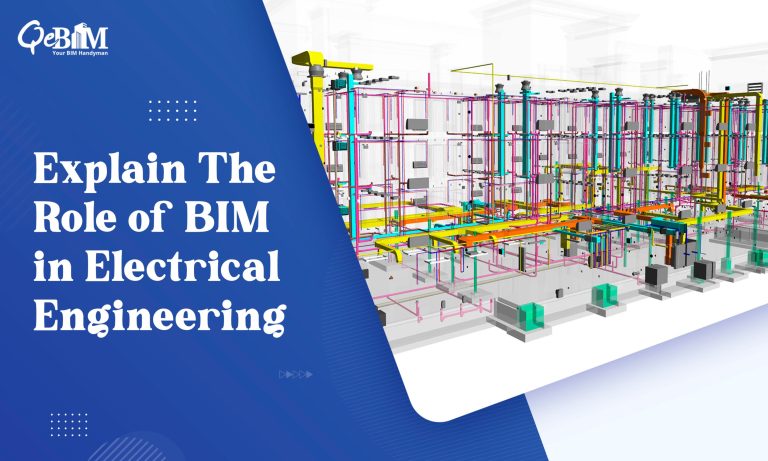Explain The Role of BIM in Electrical Engineering

As we know that BIM is becoming the pillar of the AEC industry which is transforming various sectors including the electrical engineering too. Opting for BIM holds its own set of benefits for each industry. Let us understand the same for electrical engineering. But first let’s dig into what exactly is BIM for electrical engineering?
What is BIM for Electrical Engineering?
BIM is an illustration that showcases the physical along with the functional characteristics of any building structure. In the context of electrical engineering, BIM encompasses the design, documentation as well as the management of the electrical systems within a building. This encompasses all aspects, including power distribution, lighting designs, fire alarm systems, and data networks.
MEP BIM Services allows electrical engineers to create detailed 3D models that not only visualize the electrical components but also integrate the data related to their performance, lifecycle and compliance. These models serve as a central repository of information that can be accessed and updated throughout a project’s lifecycle fostering collaboration among all stakeholders.
Why BIM is Crucial for Electrical Engineers?
Electrical engineering plays a crucial role in the building construction and even minor errors can result in costly revisions, potential electric shocks or construction delays. This is where BIM for electrical engineering comes in, addressing these challenges by facilitating improved design, coordination and planning.
Importance of BIM for Electrical Engineering
1) Enhanced Collaboration
One of the key benefits of BIM is its capacity to enhance collaboration across various disciplines. In traditional project workflows, electrical engineers often worked in isolation, resulting in possible miscommunications and mistakes.
BIM integrates all stakeholders—including architects, structural engineers as well as contractors into a single model thereby enabling the real-time collaboration. This holistic approach minimizes the risk of conflicts and ensures that everyone is on the same page ultimately leading to a smoother workflow and more successful projects.
2) Improved Visualization
BIM allows the electrical engineers to create detailed 3D models of the electrical systems. These models offer a clear visual representation of how the electrical components interact within the larger building context. This is especially advantageous during the design phase as it helps to identify the potential issues before even the construction begins.
The stakeholders can visualize lighting layouts, power distribution along with the other critical elements making it easier to assess the overall functionality and aesthetics of the design.
3) Increased Accuracy and Reduced Errors
One of the most compelling reasons for adopting BIM in electrical engineering is its ability to increase accuracy and reduce errors. Traditional design methods often lead to mistakes due to manual calculations or misinterpretations of plans.
BIM automates many of these processes by allowing engineers to simulate and analyse the systems in real time. As a result, many potential issues can be identified early thereby reducing the likelihood of costly changes during construction.
4) Efficient Project Management
BIM significantly enhances the project management capabilities. With its comprehensive data-rich models, the project managers can track progress, manage resources as well as foresee potential delays. The software allows for better scheduling and coordination of tasks which helps in keeping projects on time and within the budget.
Additionally, BIM can facilitate clash detection i.e. identifying the conflicts between various electrical systems and other building components, which can be resolved before the construction.
5) Lifecycle Management
BIM is not limited to the design and construction phases; it is essential throughout the entire lifecycle of a building. For electrical engineers, this means creating the models that include maintenance schedules, energy usage data along with the system performance metrics. These insights can help facility managers optimize the building operations, reduce energy consumption as well as extend the lifespan of electrical systems.
By integrating lifecycle management into the BIM process, electrical engineers can contribute to the sustainable building practices.
6) Enhanced Compliance and Standards Adherence
The construction industry is subject to a variety of codes, standards, and regulations. BIM helps electrical engineers ensure that their designs comply with local and national codes for all the electrical components placements.
The automated checks within BIM software can flag potential compliance issues early in the design process thereby saving time and effort during the inspections. This adherence to standards not only enhances safety but also mitigates the risk of project delays due to regulatory complications.
7) Sustainability and Energy Efficiency
BIM supports the design of sustainable electrical systems by allowing the engineers to analyse the energy performance and identify opportunities for optimization.
Through simulations and modeling, the engineers can assess the energy efficiency of different designs thereby helping to minimize the environmental impact of new buildings. This emphasis on sustainability aligns closely with global trends toward greener construction practices and energy conservation.
Conclusion
The integration of BIM into the electrical engineering represents a significant advancement in how the projects are designed, constructed and managed. By promoting collaboration, enhancing visualization along with increasing accuracy, BIM not only streamlines the engineering process but also contributes to a more sustainable as well as efficient building practices.
By leveraging the power of BIM Outsourcing Services, the electrical engineers can play a crucial role in shaping the future of the built environment ultimately ensuring that it is not only functional but also innovative and sustainable.